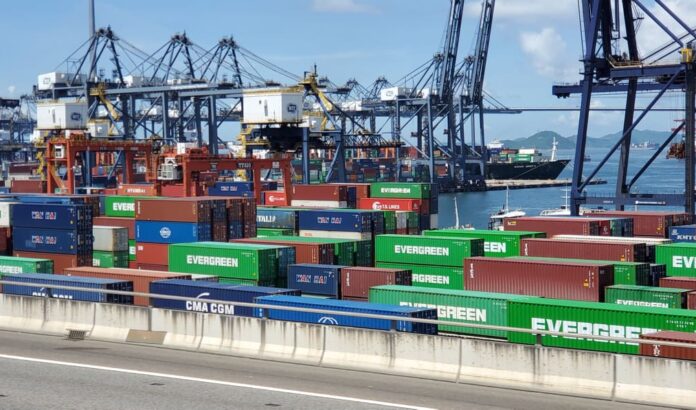
- Political intrusion in China and disruption due to quarantines are making supply chains more intensive and globalised, Transport Intelligence reports
- Threats to global trade patterns in 2020-2022 including political tensions, rising fuel cost and COVID-related port congestions seem to have not much impact on sector as trade value grows despite shrinking volume, report says
- Global supply chains in China looking elsewhere as major suppliers held by state-owned enterprises shift their focus on domestic demand and foreign firms move to Southeast Asia
- Implications of China’s changing position in global trading system are very significant for logistics markets and will have a major effect on demand for container shipping
Violent and profound short- and long-term changes in the structures of the supply chain sector stemming from political influence in China and exceptional disruption due to quarantine policies are making the players more intensive and globalised, according to a new report.
As a result, threats to global trade patterns in 2020-2022, including political tensions, rising fuel cost and port congestions due to the coronavirus contagion don’t seem to have much impact on the sector, with trade value surging despite shrinking volumes, Transport Intelligence analyst Thomas Cullen said.
In particular, global supply chains in China, the world’s biggest manufacturing base, are moving to other regions as major suppliers held by state-owned enterprises shift their focus on domestic demand, he said.
China will become less central to global supply while other regions will become of greater importance to supply chains at a global level, thus increasing levels of global trade, Cullen said in his report, “Short And Long-Term Supply Chain Trends.”
He said the globalized supply chains are underpinned by micro-economic forces against the impact of powerful macro-economic forces that are behind globalisation.
He said the reason behind globalization in terms of sourcing is a fall in major cost drivers such as production and material costs. Cullen cited transport cost is the exception, yet transport might be an enabler of lower costs in other categories.
Cullen cited politics and fuel cost as the powerful macro-economic forces that led to the structural changes in supply chains. He said China’s political influence on global trade had attracted many supply chains to invest in production facilities there and buy products from Chinese producers.
A remarkable shift in the past decade from private to state ownership of production facilities has changed the pattern of western corporations sourcing from Chinese-owned private-sector suppliers.
He said many larger firms with private sector equity but essentially state-held had been the platform for an aggressive “industrial policy” of expanding output in certain sectors, strongly affecting supply chains globally.
These players had a strategic marketing policy of gaining market share by undercutting competitors’ prices in the short term, as they had access to capital from the state banking system and other state-controlled resources such as land and energy, according to the report.
This has led to Chinese SOEs having strong positions in many sectors, such as tank containers, steel, and silk, the report said. It said more than 90% of all tank containers are made in China and those from elsewhere are made by companies owned by the SOEs.
China accounts for half of global steel output, helped by access to the huge domestic market, preferential coal and capital resources, the report said. China does export steel and caters only to domestic demand. After rationalization shut small players, large producers expanded. But margins and returns were low.
The lack transparency over ownership and finances, dependence on preferential access to capital and other resources, and leverage on the domestic market, suggest that the viability and stability of the Chinese supplier base are mixed.
This state of affairs has led global supply chains to cut dependence on China. South Korean and Japanese electronics makers such as LG, Samsung and Sony, are expanding or developing significant assembly operations in Southeast Asia. To a lesser extent, alternatives in the Philippines and Malaysia remain attractive, the report said.
For the logistics markets, the implications of the changing position of China in the global trading system are very significant, as any lessening of the proportion of sourcing out of China will have a major effect on demand for container shipping in particular, Cullen said.
Still, trades out of China will account for about 70% of all container volumes in 2022, he said. In addition, the largest container ports are situated on the Chinese coastline. To a lesser extent, this is true about airfreight as well, the report said.
The report said the price of fuel would become even more unpredictable in the short to medium term. The implications for logistics generally and freight transport, in particular, are substantial.
Two drivers of this uncertainty are the instability in the oil market resulting from lower investment and uncertain future demand for oil products, and adoption of new propulsion technologies in shipping, air transport and road freight. Fuel prices will be very volatile over the next 10 years but demand for freight transport will remain high.
The major problem over 2020 and 2021 had been congestion in logistics infrastructure, in particular, the US West Coast container ports. What has changed is the balance of trade volumes. The US in particular has seen a marked increase in imports as e-retailing has drawn into the US economy huge volumes of products made in China, Vietnam, Thailand, other parts of Southeast Asia and Bangladesh.
Imports have grown more quickly than exports. The balance of goods flows has changed, resulting in changes in container distribution. This is causing congestion in US ports and other logistics hubs.




